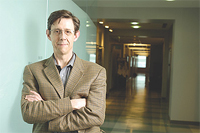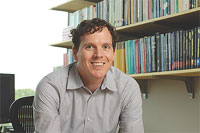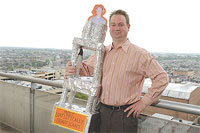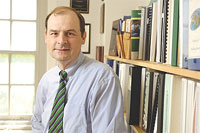2008 Golden Apple Award Winners
May 28, 2008
Faculty Recognized with 2008 Golden Apple Awards
Since 1992, the Johns Hopkins Alumni Association has annually recognized university faculty who excel in the art of instruction with its Excellence in Teaching Awards. The award allows each academic division of the university to publicly recognize the critical importance of teaching. The nomination and selection processes differ by school, but students must be involved in the selection.
The following faculty members are recipients of the 2008 Golden Apple awards, as the award is called in the Bloomberg School of Public Health.
Thomas Glass, Epidemiology, Small Class

Challenging a student's conceptions about learning is no easy task, but for Thomas Glass, rethinking traditional teaching methods is all in a day's work.
Glass, an associate professor in the Bloomberg School's Department of Epidemiology, is this year's winner for a small class. He received his first Golden Apple, as the award is known in the school, for teaching Advanced Seminar in Social Epidemiology. Glass attributes much of his success to his unconventional teaching style.
Using a seminar teaching model he first experienced as an undergraduate, Glass invites his students to set the tone by posing questions that arise from their readings and previous classroom discussions. He said he believes this model is more beneficial to his students' comprehension of the course materials.
"Although challenging, by moving away from a traditional lecture I am able to bring a different experience to public health courses and the big programs here," he said. "You can't control where the seminar is going if it is based on the students' questions, but you can provoke students' willingness to be involved if you are willing to answer their questions."
Glass admits that for some students the idea of speaking out in class can be intimidating, but he has found that injecting a little humor into a discussion helps some students to relax—a tool he learned in his first job after college, traveling to schools and community centers talking to children about sex. "Sex ed is the best way to learn the skills needed to be a successful teacher. You learn how to craft a message by being open to questions, knowing the material and being able to admit you don't have all of the answers."
It was during these presentations, Glass says, that he began a practice that he continues today—answering a random collection of handwritten questions from his students' pertaining to the course materials.
Glass says that many students view him as a tough teacher because his classroom trademark is to shout—lightheartedly, he claims—"Wrong answer" when a student answers a question incorrectly.
"It's OK to be wrong sometimes, but I've noticed students don't like to take risks. Most of my students are all-star high achievers, but they play it safe. I hope to encourage students to take risks by taking risks myself and by asking them to join me."
Glass says he is honored to win the Golden Apple award—"sometimes you have the biggest impact when you least expect it"—but that he is most thankful for his students, who inspire him to be a better instructor and researcher. "Some of my best work," he said, "has come about when students asked questions." —Natalie Wood-Wright
Brian Caffo, Biostatistics, Medium Class
 Modesty prevents Brian Caffo, an associate professor in Biostatistics, from taking too much credit for his Golden Apple teaching award, but there are a couple of things he's happy to crow over. He chalks up his success in the classroom to two things: good students and good material. "What I like about the class is that I get the best students in the school."
Modesty prevents Brian Caffo, an associate professor in Biostatistics, from taking too much credit for his Golden Apple teaching award, but there are a couple of things he's happy to crow over. He chalks up his success in the classroom to two things: good students and good material. "What I like about the class is that I get the best students in the school."
What makes his course so good? The yearlong Methods in Biostatistics (Caffo teaches Part I in the fall) encourages quality over quantity, covering fewer topics in greater depth and concentrating on core ideas.
"We don't just teach the how," he said, "we teach the why."
And that emphasis on central concepts—such as linking data to a population and the fundamentals of probability—draws enthusiastic students. He estimates that only 10 percent of his students are required to take the class—the other 90 percent enroll out of interest.
"Very few of my students have to take this class," Caffo said. "They come for the layer of abstraction."
Of course, Caffo brings considerable skill to the classroom. Having taught this course for three years, he says he knows what can make or break a class. What works: a loud-enough speaking voice, ample office hours, attention to details and emphasis on the important points. In addition, he's able to use some innate gifts. "My students think I'm patient," he says, a talent for which he credits his mother.
But diligence factors into his success as well. "There's no amount of prep that goes to waste."
On the role of a biostatistics teacher, Caffo stresses that he emphasizes the core components of the subject and how to extend those lessons to other cases. "What I mostly hope my students get out of the class is not a toolbox but a mechanism for figuring out what tools to go find, and how to come up with their own tools," he said. "This is an academic class, not a how-to."
Caffo posts all the course materials to the class Web page. Despite their virtual existence, there's something that brings the students to the brick and mortar classroom. "They come for the annotated notes," he said. "Class is pretty interactive. I get a lot of questions. Statistics is fun."
Statistics is fun? Caffo points out that the field is rich with colorful characters, including, for example, William Gosset, a Guinness Brewery statistician who developed the t-test to covertly monitor the quality of beer brews.
With all his notes and assignments online, Caffo finds it easy to spread the Methods of Biostatistics joy. He makes all his materials available to OnlineCourseWare so that students of biostatistics worldwide can tap into his lessons. "I'm a big believer in keeping everything open," he said.
With this first Golden Apple, Caffo's come a long way since his undergraduate pursuit of a major in fine arts.
"Most people fall into statistics," he said, "and that's probably the case with me." But he doesn't find biostatistics to be artless. "Plotting and graphics have some artistic component. And there's a lot of creativity that goes into research." — Christine Grillo
John McGready, Biostatistics, Large Class
 John McGready's faculty page on the school's Web site features a photo in which he's holding aloft what appears to be a three-foot, three-tiered, tin foil-covered trophy topped with his photo. He looks ridiculously happy.
John McGready's faculty page on the school's Web site features a photo in which he's holding aloft what appears to be a three-foot, three-tiered, tin foil-covered trophy topped with his photo. He looks ridiculously happy.
The tall shiny object is in fact a trophy, and McGready keeps it on the window ledge in his office, where it towers over his desk.
For the assistant scientist, it represents the crowning achievement, to date, of his eight-year teaching career at the School of Public Health. In December 2007, the 110 students in his Statistical Reasoning in Public Health class presented him with the "Most Statistically Significant" award at the end of the term. They also arranged to have a class picture taken, and it hangs, covered with student signatures, next to the trophy.
"That is a fantastic trophy, my most treasured award," McGready said. "They really went over the top. I was so blown away and grateful."
He continues to accumulate teaching honors and this year won a Golden Apple—his third—in the large-sized class category for the trophy-winning course, Statistical Reasoning in Public Health.
After eight years of teaching the class online and five on campus, the course still feels fresh to McGready. "The best way to learn statistics is to teach it many times," he said. "And I certainly learn more about the discipline every time I do it."
McGready didn't set out to teach biostatistics. While working on a master's degree in the field at Harvard, he found the time he spent as a teaching assistant to be the most rewarding part of the experience. After finishing his degree in 1996, he went to work for the Urban Institute, using statistical methodology to analyze criminal justice policy data.
Two years later, McGready was itching to get back to the classroom and took a job teaching high school math at a Washington, D.C., charter school. He also wanted to broaden his understanding of urban education issues beyond the think tank.
"I thought I needed this connective experience," McGready said, "something less research-centric and more hands-on."
In 1999, he joined the Bloomberg School's Biostatistics Department as a teaching assistant. One of his first projects was to coordinate the development of the online version of Statistical Reasoning in Public Health. He soon decided to pursue a doctorate in biostatistics.
"I was so enamored with teaching that it made sense to further my formal education," he said.
McGready began his doctoral studies and continued to teach. He was co-instructor and developer of Data Analysis Workshops I and II, offered in the school's summer and winter institutes, worked as a lab instructor and advised MPH students.
This week, after five years as a part-time doctoral student, McGready will receive his PhD. His thesis title: "Two Studies Related to Statistical Education."
"At one time grad school seemed like an unreachable entity," he said. "I feel very privileged to be here." —Jackie Powder
Thomas Burke, Health Policy and Management, Internet Class
 Thomas Burke has high expectations for his students.
Thomas Burke has high expectations for his students.
"The young people here have the drive and strength to change the world," said Burke, professor in Health Policy and Management and a four-time winner of the Golden Apple award. Students honored him this year for teaching the best Internet-based course, Introduction to Risk Sciences and Public Policy.
He credits the success of the course to his students' drive and to help from his teaching assistants.
"Our students are extremely motivated, and that's what makes this class so rewarding," said Burke, who brings a wealth of experience to the classroom, drawing on his previous, nonacademic life as deputy commissioner of health in New Jersey.
"The class uniquely combines science with case studies of real-world events to help students learn how to apply risk assessment to public health decision making," Burke said. "The competencies gained in this course will be used by the students after graduation in their jobs in the field. Hopefully, they also learn that public health is more than just measurements and experiments; it is about making change to improve people's lives."
Burke's passion for teaching came early in his career as a science teacher in an alternative high school. It was then that he first learned how to connect with his students—by joining them on the basketball court. "We shared a respect for the game and each other that ultimately translated into the classroom," he recalled.
The value that Burke places on the give-and-take between teacher and student partly explains the reservations he had about teaching an online course.
"A major part of teaching is mutual respect, and the basic interaction between instructor and student," he said. "I was concerned the Internet would interfere with my interaction with students, and [that] the prerecorded lectures could not be as current and would therefore seem less relevant."
He credits his tech-savvy teaching assistants with the success of the live online lectures that allow him to keep his class content up-to-date and to interact with students.
Burke admits he is living his dream and believes his passion and enthusiasm for public health make him a better professor. The best part of his job? "When my students go on to succeed in the field, and watching our relationship grow from that of instructor and student to professional colleagues." —Natalie Wood-Wright
Public Affairs media contacts for the Johns Hopkins Bloomberg School of Public Health: Natalie Wood-Wright or Tim Parsons at 410-955-6878 or paffairs@jhsph.edu.